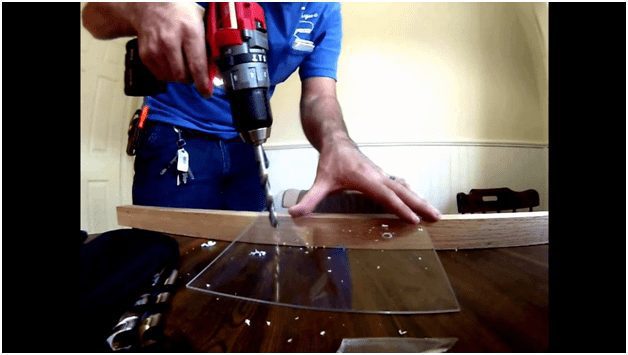
Plexiglass is arguably the most popular replacement for normal glass. This post seeks to highlight the steps to drill holes without seeking professional help.
Plexiglass, (also known as acrylic sheet, poly (methyl methacrylate), Lucite, perclax or Perspex) is popular for its features which enhance its performance. The main reason why plexiglass is preferred in place of glass is due to its lightweight and durability. Drilling and cutting your plexiglass is a simple process that does not call for professional help. However, you will need to learn the process to ensure you do not ruin your acrylic sheet.
Safety tips for drilling your plexiglass
Before you embark on working on your plexiglass, you should consider putting in place safety measures. This will ensure that you get the job done without inflicting the slightest injury on yourself. When drilling your plexiglass, below are some of the safety measures to adopt.
- Wear gloves
Gloves will come in handy to secure your hands from injuries caused by the drilling object. In addition, gloves will enhance your grip on the drill to ensure you get the job done effortlessly.
- Wear goggles
Protective goggles are important as they secure your eyes from flying particles. Owing to the sensitivity of the eyes, the smallest chip can cause eye damage and you certainly do not want that. Do you?
Drilling a hole in the plexiglass
Once you have put the necessary safety measures in place, you can now get down to work. However, you need to ensure that you have the necessary equipment. To drill your plexiglass sheet, you may consider acquiring a plexiglass drill to simplify the process. Alternatively, you can acquire plexiglass drill bits that are compatible with normal drillers. With the necessary equipment, ensure you practice the drilling process on smaller pieces of plexiglass sheet before you work on the main sheet. This will help you grasp the process to avoid making fatal mistakes on the main job. That said, below is a list of steps on how to drill a hole in your plexiglass sheet.
- Place a barrier below the plexiglass sheet
Unlike drilling a hole through metal or wood, plexiglass sheets call for extra caution. Before you start drilling, you ought to place a barrier below the plexiglass. This barrier may be a piece of wood that you would not mind drilling into. This barrier will help avoid cracking of the sheet when drilling the final hole. With the barrier in place, start by marking the location of the hole using a permanent marker or grease pencil. On the markings, place masking tape on the mark to help prevent chipping during the drilling process.
- Start drilling
Before you embark on drilling the main hole, you should consider starting with a pilot hole. The pilot hole should be at least 1/2 the diameter of the final hole. When you start the drilling process, ensure that the hole is away from the edge of the plexiglass. This will avoid cracking which may damage the entire sheet. In addition, be gentle when conducting the drilling process. Avoid center punching the plexiglass sheet and instead start the process slowly.
- Keep the drilling pace steady and slow
Once you have started drilling the hole, do not change the speed or intensify pressure on the sheet. The recommended speed rate is 89 mm or 3.5 inches per minute. As you continue drilling, the number of plastic shavings produced will increase and this may derail your view. Stop the drilling process and clear the shavings before you continue. And when the drill suddenly stops working, do not forcibly pull it out as it may cause irreversible damage to the sheet. Instead, engage the reverse feature on the driller.
- Complete the drilling process
When completing this process, ensure that you remain focused. The last stage determines the final outcome of the drilling. During the final stage of drilling, the plexiglass sheet will have endured a lot of heat due to the friction between the bit and the sheet. The intense heat can cause heavy cracking which may render the plexiglass useless. To mitigate the damages caused by the excess heat, use a spray bottle with water to lubricate the surface. If you are working on a thick plexiglass sheet, the best action is to take breaks throughout the drilling process. Continuous drilling causes excess heating which melts and damages the sheet. Taking breaks allows the plexiglass to cool thus reducing the risk of damage.
Best drill bits for use on a plexiglass sheet
Owing to the sensitive nature of plexiglass, there are various drill bits that are recommended. These bits are designed to drill holes on plexiglass sheets without exerting unnecessary pressure that causes damage. So, which are the best types of drill bits to use on your plexiglass sheet? Below is a detailed list.
- Plastic drill bits
The fact that these bits are made from plastic does not mean that they are weak. In fact, these are the perfect bits to drill your acrylic sheet. Why? Well, these bits contain ground flukes that have a 0-degree rake and 90-degree points. This feature allows the bits to scrape through the sheet layer by layer hence reducing the risk of damage. These bits come in different diameters thus you need to be cautious to ensure you find the most appropriate bit.
- Diamond-coated drill bits
Diamond drill bits are a perfect choice for drilling through your plexiglass no matter its thickness. These bits contain diamond dust coatings which ensure the cutting edges are sharp. With a 0-degree rake and 60-degree points, these bits will come in handy in enabling you to drill multiple layers. However, finding these drill bits in your local hardware can prove to be a daunting task. For this reason, you may consider purchasing them from online stores.
- Modified drill bits
You can still use the conventional high-speed drill bits to get the job done. However, they need to be modified. Modifying the drill bits is an inexpensive process that can be done at home. To modify the bits, simply grind the small flats located on the cutting edge. This will ensure the regular drill bit scrapes the layers of the plexiglass rather than fragmenting the sheet which only results in damage. To determine whether you have properly modified the bit, you should see two spiral ribbons of plexiglass emanating from the hole you are drilling.
Cutting the plexiglass sheet
At times you may want to cut the plexiglass to achieve the correct measurements. However, it is important that you do it correctly to avoid disfiguring the surface. The cutting process is quite simple as you will only require a sharp saw or hobby knife. However, there are numerous blades that are specially built to aid in cutting plexiglass sheets. But if you cannot access these special blades, you can still get the job done using readily available tools at home. When you decide to use a saw, ensure that it has ten teeth per inch. Additionally, ensure that you adopt the highest speed possible to avoid fragmenting the surface.
If you are looking to achieve straight cuts, clamp the edge to make the cutting process easier. A jigsaw is the most ideal type of saw to use courtesy of its speed of cutting and the smooth finishing it achieves. When using the jigsaw, avoid forcing the cut. This will help avoid excess friction which may disfigure the cut edge. To achieve smooth edges, you may use fine sandpaper or a wet and dry paper. Normally the most plexiglass sheets cut to size have a protective coating for protecting the surface. When cutting the acrylic sheet, you should try to avoid touching this coating as much as possible to retain the original outlook of the surface.
How to glue plexiglass sheets
When the need arises to stick together pieces of plexiglass sheets, there is an array of glue options to choose from. Among the options to choose from include:
- Tensol cement
This is arguably the perfect choice if you are looking to achieve a permanent joint. Simply apply the glue to the surface and clamp for 24 hours.
- Contact Adhesive
Most adhesives are plastic in nature and thus are perfect glue options. To use contact adhesives, all you need to do is apply on the surfaces and wait for several hours to achieve that permanent joint.
- Super Glue
Also known as a cyanoacrylate, super glue is popular for its strong bonding. When applied on the surfaces of plexiglass sheets, it only takes a few hours to achieve a joint that cannot be easily taken apart. Apart from super glue, glue gun can be used but it will depend on the type of material you want to conjoin.
The manner in which you handle your plexiglass will go a long way towards determining the final outlook. Therefore, ensure that you adopt the appropriate methods for drilling, cutting and forming joints. I hope you are now well-informed about how to successfully work on your acrylic sheets.









